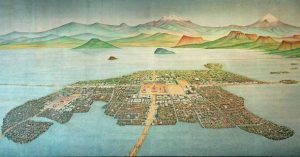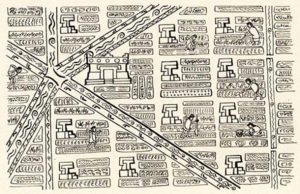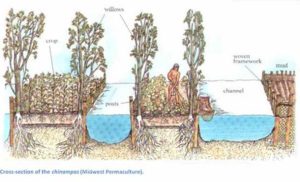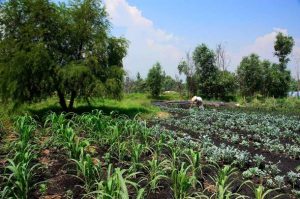The Chinampas: Mexico’s Clever Aztec “Floating” Farms

When faced with the seemingly impossible task of feeding a huge population in the ancient city of Tenochtitlan, the Aztecs came up with an ingenious solution about 1,000 years ago. Located in the midst of an enormous swamp, they used their knowledge of Mesoamerican engineering techniques and created a vast complex of seemingly floating islands that served as farmland for their burgeoning society.

Painting of Tenochtitlan-Tlatelolco on Lake Texcoco on display at the INAH in Mexico City. (Public domain)
The Aztecs, Tenochtitlan and their Ingenious Chinampas
While human sacrifice is probably the first thing that comes to people’s minds when they think about the Aztecs, there is much more to Aztec civilization than this practice. By 1519, when the first Spanish conquistadors under Hernán Cortés landed in Mexico, the Aztecs were in control of an empire that was inhabited by a population running in the millions.
Daily Life of the Aztecs: A Blend of Agriculture, Hierarchy, and Culture
Saving Chinampas, Mexico’s Ancient Floating Farms (Video)
Legend has it that goes that the Mexica, originally a nomadic tribe, were guided by a visionary revelation which prophesized that they would find their destined city when they witnessed an eagle perched on a cactus, devouring a snake. After wandering for 100 years, the Mexica finally encountered this symbolic scene on a island in the western part of Lake Texcoco—the largest of five interlinked lakes—and built their home under their leader Tenoch.
In 1325, the Mexica people are believed to have established the city-state of Tenochtitlan, the iconic capital of the Aztec Empire, in this swampy land. What few realize is that this would have been impossible without employing extensive engineering and architectural feats.
For Tenochtitlan only was made possible by exploiting the swampy land using artificial islands known as chinampas, causeways to connect the island city to the mainland, an extensive network of canals and by creating an intricate network of aqueducts to bring fresh water from the mainland. As a result, Tenochtitlan became a major cultural and political center and even the largest city in the pre-Columbian Americas until the Spanish conquest in 1521. Its population is believed to have numbered up to 300,000 people.

An artist’s impression of part of the canal network linking chinampas around Tenochtitlan. (Mexicolore)
Transforming Marsh to Productive Farmland Using Chinampas
Turning a swamp into farmland was no easy feat. Although the origins of chinampa agriculture in the Valley of Mexico remain unclear, these engineering techniques are said to have been used throughout Mesoamerica centuries prior to the rise of the Aztecs.
However, with the dawn of the Aztec Empire, a systematic program of construction was carried out over a short period of time. The need to sustain such a large population was the probable motivation behind this massive project, and the Aztec ability to organize manpower made it possible. The scale of the planning required can be seen in the overall uniformity in chinampa size and orientation, as observed in aerial surveys.

An unidentified author’s representation of a Chinampa. (Fair Use)
In essence, chinampas were artificial islands made by building up vegetation and mud under the water. A chinampa plot was constructed by staking out a rectangular enclosure, about 30 meters (98 ft) in length and 2.5 meters (8 ft) in width, into the marshy lakebed. The enclosure would then be fenced in by joining the stakes with wattle. After that, the fenced in area would be filled with mud and decaying vegetation. In order to prevent the roots from becoming water-logged, it was important that the fill brought the chinampa plot above the lake level.
While constructing the next plot, which would be parallel to the first, a narrow canal for the passage of canoe would be left in between these two chinampa plots. Over time, the lake was reduced to canals and islands, with the canals surrounding the chinampa plots creating the illusion that these agricultural lands were floating on water, hence its misattribution as “floating gardens.”

A farmer harvesting his crop on a chinampa. (Maleny / Adobe Stock)
To further stabilize these plots of land, willows were planted around the perimeter. This is due to the dense root system which, over time, anchored the retaining walls of the structure and reduced the effects of erosion.
Diverse crops, including maize, beans, chillies, squash, tomatoes and edible greens flourished in the meticulously planned plots. Vibrant flowers, crucial for religious festivals, also adorned the fields. Strategic seedbed use facilitated a seamless cycle of planting and harvesting, optimizing agricultural productivity. There was also a healthy stock of fish and birds in the canals which created an additional food source.

Illustration representing the floating gardens known as chinampas. (Public domain)
Aztec Engineering and their Management of Water
In order to ensure that the chinampas produced good harvests throughout the year, it was vital that the supply of water was well managed. During the rainy season, flooding would have been a problem. Hence, a sophisticated drainage system, which included dams, sluice gates and canals, were put in place to counter this problem.
This management of the supply of water is further evidence of the well organized agricultural project by the Aztec Empire. During the dry season, however, moisture had to be maintained, and this was done manually by carrying water in containers from the canals to the plants in the chinampa plots.
As for fertilizers, the Aztecs used human excrement collected in canoes from the city of Tenochtitlan. By using human excrement to fertilize the crops, the Aztecs were also able to create a healthier living environment as the city’s wastewater would have also been treated. It has even been claimed that the city of Mexico once attempted to create a wastewater treatment system which functioned along the lines of the Aztec chinampa system.
What is most fascinating about the chinampas is human agency. Although the Aztecs may seem like a blood-thirsty race, their ability to exploit the landscape to their advantage shows human ingenuity and sophistication.

Ten Things the Ancients Did Better than Us
Religion of the Aztecs: Keeping the Balance in an Unpredictable and Terrifying World
In addition, the organization of the chinampa building program and the management of its water supply by the Aztec Empire is further evidence of the highly developed society that was attained by the Aztec peoples.
Xochimilco is home to some of the last remaining chinampas. (GoCarlos / Adobe Stock)
While it’s hard to imagine when surveying the cityscape of modern-day Mexico City, this area was once covered by lakes and swamps. As the years have passed, the once-thriving lake that bore witness to the ingenious creation of chinampas has been drained, replaced by urban development.
Xochimilco in southern Mexico City stands as a tourist attraction, a mere vestige of the expansive water transport system and artificial islands. Tourists now traverse its canals in trahuneras, colorful boats reminiscent of gondolas. Recognized as a World Heritage Site in 1987, Xochimilco struggles to preserve its history and traditions amid pollution, deterioration and encroaching settlements. Today, only about 3,000 chinampas endure, a dwindling testament to a fading culture, sustained by a handful who uphold tradition amidst the challenges of modernity.